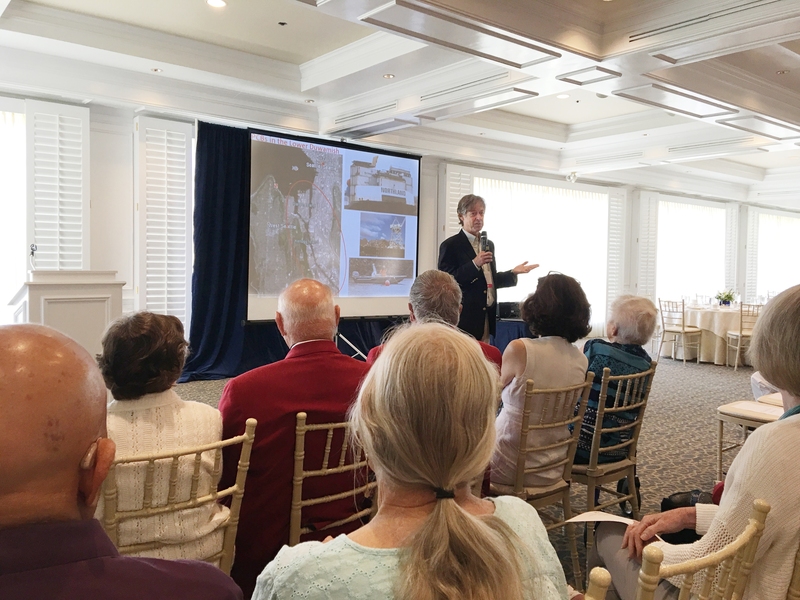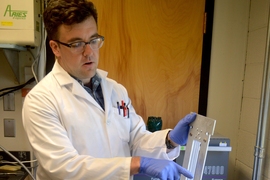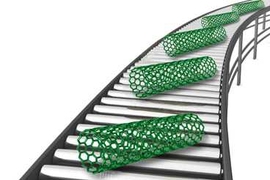On July 27, Department of Civil and Environmental Engineering Professor Philip Gschwend presented on environmental topics to approximately 75 MIT alumni in Mashpee, Massachusetts.
The room was filled with red jackets, a signature of those who have been MIT alumni for at least 50 years. Attendees also included members of the Cardinal and Gray Society and the Emma Rogers Society, whose purpose is to gather together periodically to socialize and engage in intellectual conversations. The air was filled with comradery and laughter — a clear sign that this group was not new to each others’ company.
An audience ready to learn
Theodore (Ted) Korelitz ’56, chair of the Cardinal and Gray Society, welcomed everyone and recognized those who made special efforts to attend, including the most senior alumnus present, Clifford Woods ’46, who arrived with his wife, Patricia.
Korelitz then introduced Gschwend, the Ford Professor of Civil and Environmental Engineering and director of the Ralph M. Parsons Laboratory for Environmental Science and Engineering, who spoke on the topic: “Environmental Pollution: Do Our Remedial Solutions Solve the Problems?”
Gschwend encouraged the group to ask questions throughout his presentation, and the attendees responses showed they were engaged, passionate, and actively involved.
“At MIT, we try to come up with solutions,” said Gschwend. “But for environmental problems, often the best thing you can do is to first step back and consider if the perceived cause of a problem is the right thing to correct. That’s the important question with which I think we have to start, but that’s often not how we proceed to address unhealthy environmental situations now.”
Gschwend then brought the audience back to California in the 1960s. He showed photos with smog covering up views of the mountains. He described how there was a very high toxic concentration of ozone then that paired with the already existing smog.
Gschwend repeated what environmentalists said back then, “We know what the problem is — we can see it. It must have to do with the exhaust coming out of cars, the hydrocarbon fuels that did not get burned in the engines.” The thinking of that day was the solution would be to just add a device to tailpipes to remove the hydrocarbons and the smog and ozone would disappear.
Gschwend explained that this solution was insufficient, however, because it was discovered that it is not only hydrocarbon emissions causing the high concentration of ozone, but also nitrogen oxide emissions. It wasn’t until the 1980s, when the chemistry of this air-pollution problem was really understood much better, that the catalytic converter, which finally helped reduced the ozone pollution, was invented.
“You have to truly understand the problem, as opposed to saying immediately 'I know what that is,' and trying to fix it, because it does not always work, and you waste a lot of time and resources.”
Gschwend then talked about the phosphorus pollution in Lake Erie and how people originally believed it stemmed only from laundry detergent. But a ban on phosphorus in detergent did not solve the problem. He explained that again this solution was over-simplified in that the phosphorus use in agriculture was neglected and was increasingly leaching into the lake, and hit home his point that such environmental problems need to be thought of as systems.
His talk then transitioned into environmental issues caused by chemical spillage of substances like DDT from commercial use. Gschwend says that while he is a geochemist and an environmental chemist, he is not opposed to the use of freons and DDTs. He says they do great things to solve technical problems and are economically useful. DDT certainly helped in the fight against malaria, he explained. The real issue, he said, is that the chemicals are used without proper attention to the “potential unintended consequences of their production, transport, and use when solving a problem.”
Gschwend went through various examples of chemical spills occurring and companies’ trying to fix a singular problem, when what was really needed was to plan and implement a total systems solution as a chemical/material product’s use was initially being implemented. He questioned, “Why aren’t companies doing anything to prepare for the spills ahead of time?” He emphasized, “who isn’t ready to clean up spilled milk in the kitchen? We know it will happen!”
Relatable findings
Throughout the talk and luncheon, alumni and guests repeatedly offered their opinions and feedback. From groans of frustration, to inquisitive questions about local environmental issues, it was clear the audience related to Gschwend’s key message: complex problems should include a broad analysis and understanding of causes and issues. Moreover, as people continue to affect the environment, and changes in the environment in turn impact people, real solutions to problems often require a larger-scale systems approach. And this thinking should be developed at the outset of producing/using chemicals and materials.
President and webmaster of the class of 1956, and Department of Civil and Environmental Engineering alumnus, Ralph Kohl said he “very much enjoyed” the day, and found Gschwend to be “very lively,” adding “I can only imagine what his exams would be like!”








